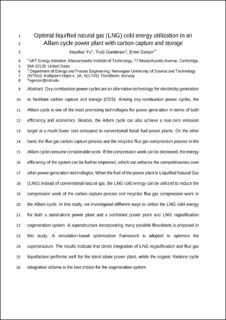| dc.contributor.author | Yu, Haoshui | |
| dc.contributor.author | Gundersen, Truls | |
| dc.contributor.author | Gencer, Emre | |
| dc.date.accessioned | 2021-11-04T12:49:38Z | |
| dc.date.available | 2021-11-04T12:49:38Z | |
| dc.date.created | 2021-02-15T20:41:58Z | |
| dc.date.issued | 2021 | |
| dc.identifier.citation | Energy Conversion and Management. 2021, 228 . | en_US |
| dc.identifier.issn | 0196-8904 | |
| dc.identifier.uri | https://hdl.handle.net/11250/2827908 | |
| dc.description.abstract | Oxy-combustion power cycles are an alternative technology for electricity generation to facilitate carbon capture and storage (CCS). Among oxy-combustion power cycles, the Allam cycle is one of the most promising technologies for power generation in terms of both efficiency and economics. Besides, the Allam cycle can also achieve a near-zero emission target at a much lower cost compared to conventional fossil fuel power plants. On the other hand, the flue gas carbon capture process and the recycled flue gas compression process in the Allam cycle consume considerable work. If the compression work can be decreased, the energy efficiency of the system can be further improved, which can enhance the competitiveness over other power generation technologies. When the fuel of the power plant is Liquified Natural Gas (LNG) instead of conventional natural gas, the LNG cold energy can be utilized to reduce the compression work of the carbon capture process and recycled flue gas compression work in the Allam cycle. In this study, we investigated different ways to utilize the LNG cold energy for both a stand-alone power plant and a cogeneration system with power generation and LNG regasification. A superstructure incorporating many possible flowsheets is proposed in this study. A simulation-based optimization framework is adopted to optimize the superstructure. The results indicate that direct integration of LNG regasification and flue gas liquefaction performs well for the stand-alone power plant, while the organic Rankine cycle integration scheme is the best choice for the cogeneration system. | en_US |
| dc.language.iso | eng | en_US |
| dc.publisher | Elsevier | en_US |
| dc.rights | Attribution-NonCommercial-NoDerivatives 4.0 Internasjonal | * |
| dc.rights.uri | http://creativecommons.org/licenses/by-nc-nd/4.0/deed.no | * |
| dc.title | Optimal liquified natural gas (LNG) cold energy utilization in an Allam cycle power plant with carbon capture and storage | en_US |
| dc.type | Peer reviewed | en_US |
| dc.type | Journal article | en_US |
| dc.description.version | acceptedVersion | en_US |
| dc.rights.holder | This is the authors' accepted manuscript to an article published by Elsevier. Locked until 9.12.2022 due to copyright restrictions. The AAM is made available under the CC-BY-NC-ND 4.0 license http://creativecommons.org/licenses/by-nc-nd/4.0/ | en_US |
| dc.source.pagenumber | 11 | en_US |
| dc.source.volume | 228 | en_US |
| dc.source.journal | Energy Conversion and Management | en_US |
| dc.identifier.doi | 10.1016/j.enconman.2020.113725 | |
| dc.identifier.cristin | 1890133 | |
| cristin.ispublished | true | |
| cristin.fulltext | postprint | |
| cristin.qualitycode | 1 | |

